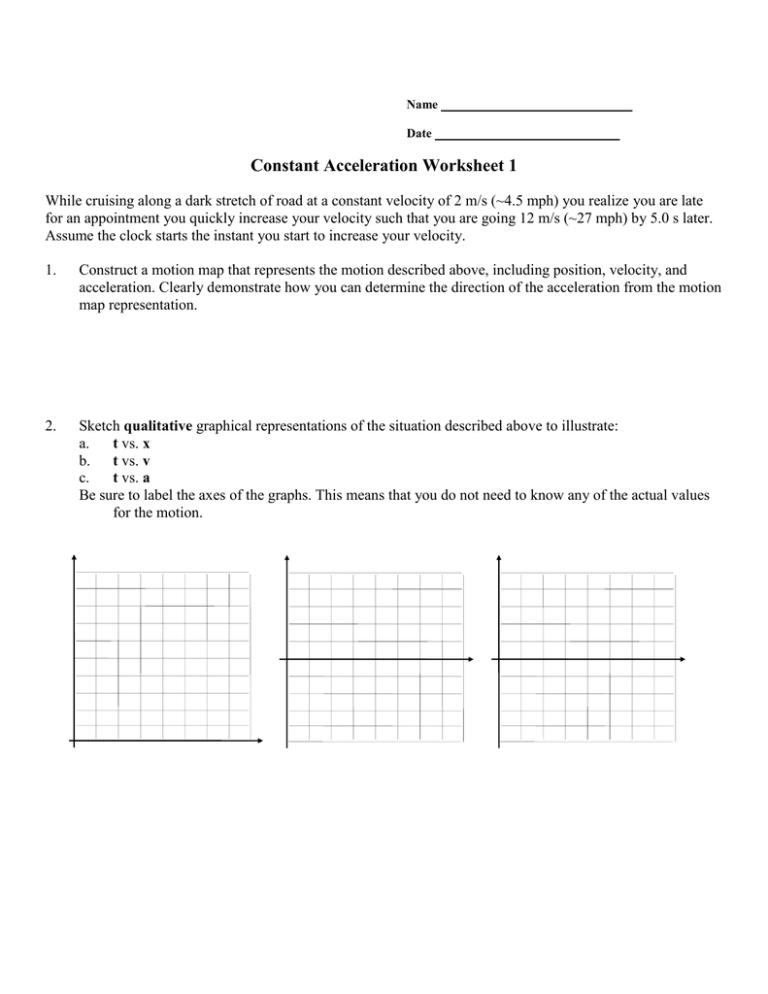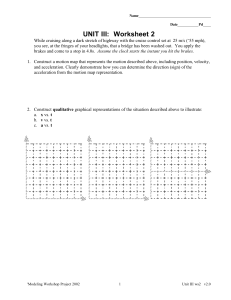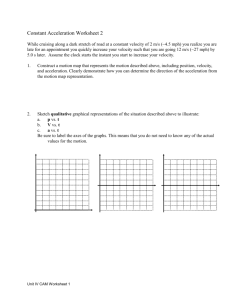Unit III wksht 2
advertisement

Name Date ________________ Constant Acceleration Worksheet 1 While cruising along a dark stretch of road at a constant velocity of 2 m/s (~4.5 mph) you realize you are late for an appointment you quickly increase your velocity such that you are going 12 m/s (~27 mph) by 5.0 s later. Assume the clock starts the instant you start to increase your velocity. 1. Construct a motion map that represents the motion described above, including position, velocity, and acceleration. Clearly demonstrate how you can determine the direction of the acceleration from the motion map representation. 2. Sketch qualitative graphical representations of the situation described above to illustrate: a. t vs. x b. t vs. v c. t vs. a Be sure to label the axes of the graphs. This means that you do not need to know any of the actual values for the motion. 3. Construct quantitatively accurate graphical representations of the situation described above for: a) t vs. v b) t vs. a 4. On the t vs. v graph above, graphically represent your displacement. (i.e., what part of the velocity time graph tells you the displacement or how far you went). 5. Utilizing the graphical representation, determine how far the bike traveled. (Please explain your problem solving method or show the method in detail) 6. Did you, according to your graph, have a constant acceleration after you started to increase your velocity? Please explain how you know. 7. From the t vs. v graph, determine the acceleration once you started to increase your velocity. (Please show your work) 8. Using an algebraic representation determine how far you traveled during the time it was accelerating. (Show your work.) CONSTANT ACCELERATION WORKSHEET 2 While cruising along a dark stretch of highway with the cruise control set at 20 m/s (55 mph), you see, at the fringes of your headlights, that a bridge has been washed out. You apply the brakes and come to a stop in 4.0s. Assume the clock starts the instant you hit the brakes. 1. Construct a motion map that represents the motion described above, including position, velocity, and acceleration. Clearly demonstrate how you can determine the direction (sign) of the acceleration from the motion map representation. 2. Construct qualitative graphical representations of the situation described above to illustrate: a. t vs. x b. t vs. v c. t vs. a Be sure to label the axes of the graphs. 3. Construct quantitatively accurate graphical representations of the situation described above for: a) t vs. v b) t vs. a 4. On the t vs v graph above, graphically represent the car’s displacement during braking. 5. Utilizing the graphical representation, determine how far the car traveled during braking. (Please explain your problem solving method.) 6. Did the car, according to your graph, have a constant acceleration after the brakes were applied? Please explain how you know. 7. From the t vs v graph, determine the acceleration of the car once the brakes were applied. (Please show your work) 8. Using a mathematical representation determine how far the car traveled during braking. (Show your work.) 9. If the bridge is 35 meters away from your starting locatio-n how did your evening end



